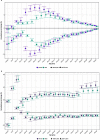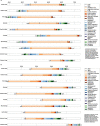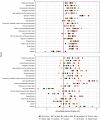Health trends, inequalities and opportunities in South Africa's provinces, 1990-2019: findings from the Global Burden of Disease 2019 Study
- PMID: 35046100
- PMCID: PMC8995905
- DOI: 10.1136/jech-2021-217480
Health trends, inequalities and opportunities in South Africa's provinces, 1990-2019: findings from the Global Burden of Disease 2019 Study
Abstract
Background: Over the last 30 years, South Africa has experienced four 'colliding epidemics' of HIV and tuberculosis, chronic illness and mental health, injury and violence, and maternal, neonatal, and child mortality, which have had substantial effects on health and well-being. Using data from the 2019 Global Burden of Diseases, Injuries and Risk Factors Study (GBD 2019), we evaluated national and provincial health trends and progress towards important Sustainable Development Goal targets from 1990 to 2019.
Methods: We analysed GBD 2019 estimates of mortality, non-fatal health loss, summary health measures and risk factor burden, comparing trends over 1990-2007 and 2007-2019. Additionally, we decomposed changes in life expectancy by cause of death and assessed healthcare system performance.
Results: Across the nine provinces, inequalities in mortality and life expectancy increased over 1990-2007, largely due to differences in HIV/AIDS, then decreased over 2007-2019. Demographic change and increases in non-communicable diseases nearly doubled the number of years lived with disability between 1990 and 2019. From 1990 to 2019, risk factor burdens generally shifted from communicable and nutritional disease risks to non-communicable disease and injury risks; unsafe sex remained the top risk factor. Despite widespread improvements in healthcare system performance, the greatest gains were generally in economically advantaged provinces.
Conclusions: Reductions in HIV/AIDS and related conditions have led to improved health since 2007, though most provinces still lag in key areas. To achieve health targets, provincial governments should enhance health investments and exchange of knowledge, resources and best practices alongside populations that have been left behind, especially following the COVID-19 pandemic.
Keywords: HIV; health policy; healthcare disparities; public health.
© Author(s) (or their employer(s)) 2022. Re-use permitted under CC BY. Published by BMJ.
Conflict of interest statement
Competing interests: AES reports personal fees from Servier, Novartis,Takeda, Omron Healthcare, and Abbott, outside the submitted work. DJS reports personal fees from Lundbeck, Takeda, Johnson & Johnson, and Servier, outside the submitted work.
Figures






References
Grants and funding
LinkOut - more resources
Full Text Sources
